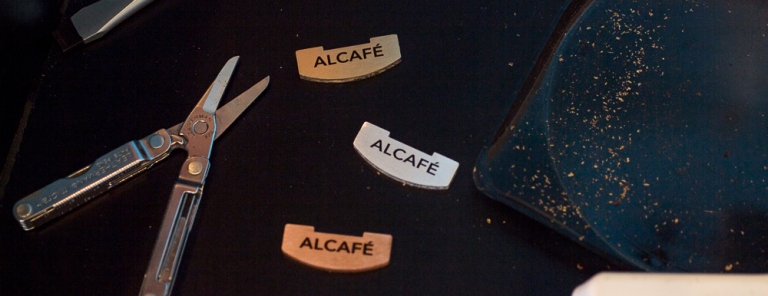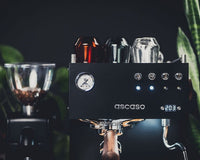We all love our Mahlkonig EK43 grinders, right? One of the most consistent grinders on the market, which means they get a lot of daily use. If you have one in your cafe then you know it can require a bit of maintenance. Shear plates break often and the day won’t run as smoothly with your EK43 out of service.
Let me introduce you to Alcorn Café Engineering, also known as ACE, a new and exclusively Espresso Parts product line of highly engineered modifications for espresso machines and grinders. They have developed a shear plate kit that has yet to need replacing… which is something we can’t say about the factory shear plates.
ACE may just change your EK43 life. The kit was designed as a customer experiment with three different materials to see which withstands the pressure. We sat down with the engineer behind the project, Sean Alcorn, to give you background on how the product was developed and other tips on how to keep your EK43 Grinder working at its best.

1. What sparked the ACE Shear Plate Kit?
Our service division maintains the equipment of a lot of high-end clients in Sydney. These clients were expressing their frustrations due to the plates breaking so frequently. The official word from the Mahlkönig importer stated the grinders were not being used properly. You should not restart the grinders as they are still spinning. In some situations, this may be the cause of the breakage but not always, not for a number of times the plates break. On top of this, the plates would always be out of stock. How could I explain to a client that their valuable asset needs to sit idle while I wait for a piece of alloy to come from Germany. The industry (at least here) was begging, borrowing and stealing them from each other.

2. How did you land on the three Materials for the Shear Plate Kit?
The first step was to recognize that there was nothing at all wrong with the EK43 and the way it was designed. The EK43 was originally intended as a retail spice grinder – grinding the occasional batch of spices throughout the day. Then at some point, Mahlkönig put some coffee burrs in it and it was still – a retail batch grinder for coffee or what we sometimes refer to as a ‘deli grinder’ in Australia. Once we acknowledge that the grinder is not being used as it was originally intended, then we can think “OK, so how do we resolve this?”. Put simply, the grinder was not designed for the continual stop/start cycles grinding 20 grams of coffee. But that is OK – that is the sort of thinking that drives us forward.
So each plate I replaced, I would take the (usually 3 pieces) of the old plate home with me, clean it up and inspect. In almost all cases – bar one that I saw, I firmly believe that the metal had been ‘work hardened’ to the point where it simply fractured. There was no evidence to suggest that *any* of these plates had sheared as the original designer intended. I truly believed that by studying the sheer strengths of the multitude of alloys that there was available to us – including dozens of aluminum and more than just one type of ‘brass’ or ‘copper’. I set about sourcing small amounts of material and again cutting plates by hand. We ran each plate for hundreds of hours and performed thousands of stop-start tests. Of interest was that when setup on a timer and stopped and started without coffee – the original plate would still fatigue and break. It simply took a little longer. This gave weight to our theory that the coffee was not the cause.
Finally – once I’d satisfied myself of the suitability of those 3 materials (and I do have a preference), we decided to put out our “Crowd Testing Kit”, but alas, we have had absolutely no feedback other than “none have broken from fatigue as the factory ones!”

3. Any other tips for Mahlkonig EK/EKK users?
1. The industry as a whole recommends that you start the grinder first, allow the motor to come up to speed (you will hear a distinctive click and then a gradual ‘balancing out’ of the motor a few seconds later). WAIT for this and then add the beans or open the hopper. I fully agree with this approach.
2. ALWAYS have a spare! I did all the hard work, but until recently I was on the other side of the world. It’s not too hard to be prepared. Get a small zip lock bag and put both a spare ACE Shear plate and a 3mm Allen key inside and tape to the underside of the grinder. With these two parts – and hopefully a tube of lube and a ‘barista’s screwdriver under the bench – a speedy replacement can occur and you can immediately order a replacement from
espressoparts.com when the shift is over.
3. Regular Cleaning – as with any grinder – both the EK itself and the coffees you are serving will benefit from a regular cleaning program. Purchase the correct size screwdriver (probably should apply to tip 2 also) and a couple of awls and *gently* remove the rotating plate. Do not force anything. There is nothing more disappointing to a technician than seeing an expensive grinder that has been butchered. Clean thoroughly with your choice of weapons – soft brush, vacuum cleaner, soft clean cloths, etc. then re-lube all metal to metal contact points with a good food grade lubricant – avoiding lube anywhere in the coffee path. Reassemble and recalibrate (you will need the 3mm Allen key from point 1). DO NOT make adjustments to the front plate whilst disassembled – you will only make recalibrating so much harder.
We will continue to work with ACE in our partnership to bring you new coffee technology. We are excited to be Exclusive Distributors for ACE and we’re welcoming Wholesale and Reseller inquiries.










